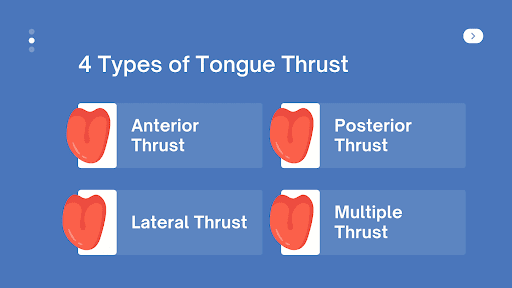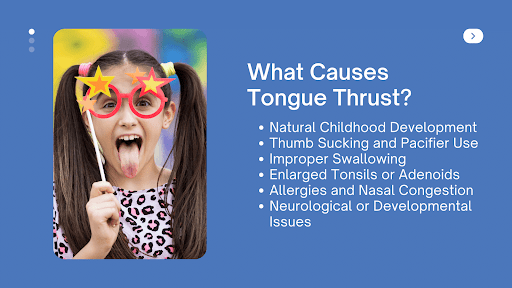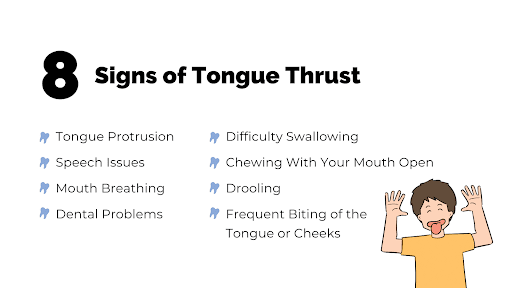Tongue thrusting might sound like a cool ninja move, but it’s actually something many of our patients do without even realizing it.
It occurs when the tongue pushes against your teeth when you swallow, talk, or rest.
Over time, this pushing movement shifts your teeth, messing up your smile.
The encouraging news?
Orthodontic treatment can help fix it!
Let’s dive into the tongue thrust topic and uncover how the magic of braces and other orthodontic tools can tackle this dental issue head-on.

What is Tongue Thrusting?
Tongue thrust occurs when your tongue is pushing against the front teeth when you swallow, speak, or rest your tongue.
It might sound inoffensive, but we must not forget how strong our tongue muscles are. If it keeps pushing against our teeth repeatedly, it can make them shift or become misaligned. That’s why dentists and orthodontists pay attention to it!
Kids often present the tongue thrust habit, but many grow out of it. However, if they don’t, it will lead to orthodontic problems down the line. Some people even carry this habit into adulthood. It’s essential to be aware of this subconscious habit—addressing it early will save a lot of dental trouble in the future!
Tongue Thrusting in Infants
Tongue thrust habits are to be expected during infancy. It’s Mother Nature’s way of ensuring babies don’t choke when feeding. When drinking milk from a bottle or breastfeeding, this reflex helps them push milk to the back of their mouth to swallow. It’s like a built-in safety mechanism!
This natural reflex should fade away as toddlers start eating solid foods. Any persistence of this habit calls for specialized care.
The prevalence of a child’s tongue thrust decreases from 55% to 35% between the ages of 3 and 5.
Tongue Thrusting in Adults
For grown-ups, tongue thrust is more of a habit where the tongue pushes against the front teeth, especially when swallowing, speaking, or resting.
The constant pressure from the tongue may cause dental misalignment if unchecked. Imagine your teeth being slowly pushed forward every time you swallow!
Additionally, tongue-thrusting habits lead to speech impediments, making it tricky for others to understand your utterances.
Between 5% and 15% of older children and adults require tongue thrust therapy.
4 Types of Tongue Thrust

- Anterior Thrust: The most common type of tongue thrust. The tongue is pushing against the front teeth when you swallow.
- Lateral Thrust: The tongue doesn’t just go forward; it pushes out to the sides, especially against the side teeth or the cheeks. Patients may experience either unilateral thrust or bilateral thrust.
- Posterior Thrust: The tongue pushes against the roof of the mouth, right behind the front teeth, instead of pushing forward. It’s like the tongue is trying to give the roof of the mouth a high-five!
- Multiple Thrust: This is the “all-in-one” type. Here, the tongue might push against the teeth, to the sides, and even upwards simultaneously.
What Causes Tongue Thrust?

- Natural Childhood Development: All babies start with a tongue thrust. It’s a natural behavior that helps babies breast- or bottle-feed. Most kids grow out of this as they age, although some hang onto it longer.
- Thumb Sucking and Pacifier Use: If a kid is into thumb-sucking or using pacifiers for a long time, it might encourage the tongue to keep thrusting forward.
- Improper Swallowing: Sometimes, it’s a matter of not having learned to swallow the “standard” way. Instead of the tongue pushing up against the roof of the mouth, it pushes forward.
- Enlarged Tonsils or Adenoids: When your tonsils or adenoids become enlarged, they hinder breathing through the nose. The more your mouth stays open, the more space your tongue has to thrust forward.
- Allergies and Nasal Congestion: If your nose is acting up due to allergies or nasal congestion, you’re more likely to resort to mouth breathing. Like with swollen tonsils, an open mouth invites the tongue to push forward.
- Neurological or Developmental Issues: Although uncommon, a few tongue thrust cases are linked to specific neurological (for example, cerebral palsy, Down syndrome, and Autism spectrum disorder) or developmental conditions.
Can Anxiety Cause Tongue Thrusting?
Anxiety causes us to develop different habits without even realizing it. Think about biting one’s nails, tapping your feet, or playing with your hair when stressed out. Similarly, you might unconsciously push your tongue against your teeth or thrust it forward as a knee-jerk reaction to anxiety.
While anxiety doesn’t directly cause tongue thrust, the habits you pick up when anxious point toward this habit.
For instance, tongue thrust is more likely to occur if you exhibit these behaviors when stressed:
- Constantly breathing through your mouth
- Grinding your teeth
- Clenching your jaw
8 Signs of Tongue Thrust

- Tongue Protrusion: One of the main signs of the tongue thrust reflex is the tongue poking out between the front teeth when speaking or swallowing.
- Speech Issues: With the tongue playing peek-a-boo, it might make some utterances sound a little wonky. We’re talking about the “S,” “Z,” “Sh,” and “J” sounds.
- Mouth Breathing: Patients with untreated tongue thrust often breathe through their mouth instead of their nose.
- Dental Problems: Over time, the constant pressure of the tongue pushing against the teeth will cause them to move. This process creates gaps between the teeth and makes the front teeth stick out.
- Difficulty Swallowing: Instead of a smooth action, swallowing looks more like a strong, exaggerated tongue push.
- Chewing With Your Mouth Open: Since the tongue is pushing forward, some patients find it easier to chew with their mouth open.
- Drooling: With the tongue not always in its proper place, it might cause some drooling, especially while sleeping.
- Frequent Biting of the Tongue or Cheeks: Because the tongue’s position is a bit off, it might lead to accidental biting of the tongue or the insides of the cheeks.
Tongue Thrust Diagnosis

Every tongue thrusting diagnosis follows a set of customary steps:
- Observation: Experts like speech therapists or orthodontists will pay close attention to how you speak and swallow. They’ll check to see if the tongue pokes out during certain sounds or while swallowing. They might even ask you to eat or drink something during the consultation to see it in action.
- Medical History: Experts will ask about any history of speech or swallowing issues, dental problems, or other related concerns.
- Speech Testing: The expert will ask you to pronounce certain words and sounds to pinpoint any speech problems tied to tongue thrusting. They’re listening to see if any sounds are distorted because of how the tongue moves.
- Physical Examination: The focus is on the position of the tongue and the state of your teeth and palate.
- Questions: The expert will ask about early childhood habits like thumb-sucking or prolonged bottle-feeding. Believe it or not, these can contribute to tongue thrust!
How Do Experts Treat Tongue Thrust?
Seeing a Speech Language Pathologist
Your speech therapist will teach you exercises and techniques toward training your tongue to sit and move correctly. It’s like going to the gym but for your tongue!
Myofunctional Therapy
Myofunctional therapy is a series of exercises focusing on the tongue and facial muscles. These exercises improve the strength and movement of the tongue. With enough practice, the tongue learns to move normally over time.
Orthodontic Treatment
Your orthodontist also plays a solid role in your treatment process.
If your teeth have shifted because of tongue thrust, braces and other dental appliances will help get those teeth back in line.
Otherwise, your orthodontist will provide a tongue crib device to keep the tongue in the correct position, especially while swallowing.
A tongue crib is a particular orthodontic appliance made of metal wires that fit behind your top front teeth. These wires form a barrier that prevents the tongue from pushing against the teeth and the roof of the mouth. Instead of the tongue sneaking forward, the crib encourages it to rest in the bottom of the mouth—where it should be.
“Do tongue cribs hurt?” “Are they uncomfortable?” Like any new device in your mouth, a tongue crib might initially feel strange. But after a while, you’ll get used to it.
Can Orthodontic Treatment Address Tongue Thrusting?
While braces and invisible retainers might aid your treatment, they’re not a magic cure-all for tongue thrusting.
It’s like having a tool in a toolbox. Orthodontic appliances can be part of the solution, especially if the teeth need straightening.
However, most patients with tongue thrust mainly benefit from treatment avenues such as speech therapy or myofunctional therapy.
The Dangers of Untreated Tongue Thrust
While tongue thrusting seems like a simple, maybe even quirky, habit, it can lead to some not-so-fun consequences over time.
First off, our mouths are a carefully balanced ecosystem. Everything’s arranged just so, from our teeth to our jaws.
When the tongue constantly pushes against the teeth, it’s like an earth-moving bulldozer, pushing the teeth out of their proper positions. While there’s nothing wrong with crooked teeth, if you aim for that straight-teeth look, tongue thrusting will set you back.
Incorrect tongue positioning will also mess with your jaw alignments, setting you up for an overbite or an underbite. Having an improper bite can lead to jaw pain, headaches, and even speech impediments.
Our tongue plays a starring role when we talk, helping us pronounce words and sounds correctly.
If it’s constantly thrusting forward, it can mess with our speech patterns. This means certain sounds or words might come out distorted or unclear. For kids, especially, it can lead to teasing or feeling self-conscious.
Finally, there’s the swallowing aspect.
Every time we swallow, we use a set of muscles in a specific sequence. This sequence can get jumbled up when you have a tongue-thrusting habit. This might not sound like a big deal, but it can lead to eating and even digestion issues over time.

Address Your Problematic Tongue Thrust With Dr. Lee’s Help!
Contact Patuxent Orthodontics if orthodontic care is the solution to your dental woes. Whether you want to learn more about the benefits of orthodontic care or have questions about the process, use our live chat or call (240) 802-7217 or message us through our Contact Us page to connect with our friendly staff today and book a complimentary consultation!
Our office, located at 44220 Airport View Dr., Hollywood, MD 20636, proudly serves Maryland’s Patuxent area, as well as the Greater Washington DC area. So, if you’re residing in Hollywood, Wildewood, or Leonardtown and are looking for one of the best orthodontists in Maryland, don’t hesitate to visit our office!
We also invite you to keep up with our blog to get answers to many of the frequently asked questions about maintaining your perfect smile, and follow us on Facebook and Instagram to become a part of our smiling community!
References
- Gotter, Ana. “Tongue Thrust in Children and Adults.” Healthline, Healthline Media, 24 Mar. 2020, www.healthline.com/health/tongue-thrust#complications. Accessed 22 Sept. 2023.
- Larrazabal, Mikee. “Tongue Thrust – What and How to Stop It.” Tongue Thrust and How to Stop It, Better Speech, 11 Aug. 2023, www.betterspeech.com/amp/what-is-tongue-thrust-how-to-stop-it-for-children-and-adults. Accessed 22 Sept. 2023.
- Santini, Milagros. “What Is Tongue Thrusting and How Can It Be Fixed?” Saxe Orthodontics, 5 May 2022, saxeortho.com/what-is-tongue-thrusting-how-can-it-be-fixed/. Accessed 22 Sept. 2023.
- “Tongue Thrust.” Tongue Thrust – an Overview | ScienceDirect Topics, www.sciencedirect.com/topics/medicine-and-dentistry/tongue-thrust. Accessed 22 Sept. 2023.
- “What Is Teeth Tongue Thrust & How to Fix Tongue Thrusting Habits?” NewPark Orthodontics, 13 Sept. 2023, newparkortho.com/how-orthodontists-can-help-with-tongue-thrusting-habit/. Accessed 22 Sept. 2023.
- “What Is Tongue Thrust and Why Is It a Concern?” Kids Mile High, 20 Sept. 2023, www.kidsmilehigh.com/what-is-tongue-thrust-and-why-is-it-a-concern/. Accessed 22 Sept. 2023.
- “What Is Tongue Thrust in Adults: Signs, Affect on Face & Teeth, How to Stop?” What Is Tongue Thrust in Adults: Signs, Affect on Face & Teeth, How to Stop?, www.mewing.app/blog/what-is-tongue-thrust-how-to-stop-tongue-thrusting. Accessed 22 Sept. 2023.











